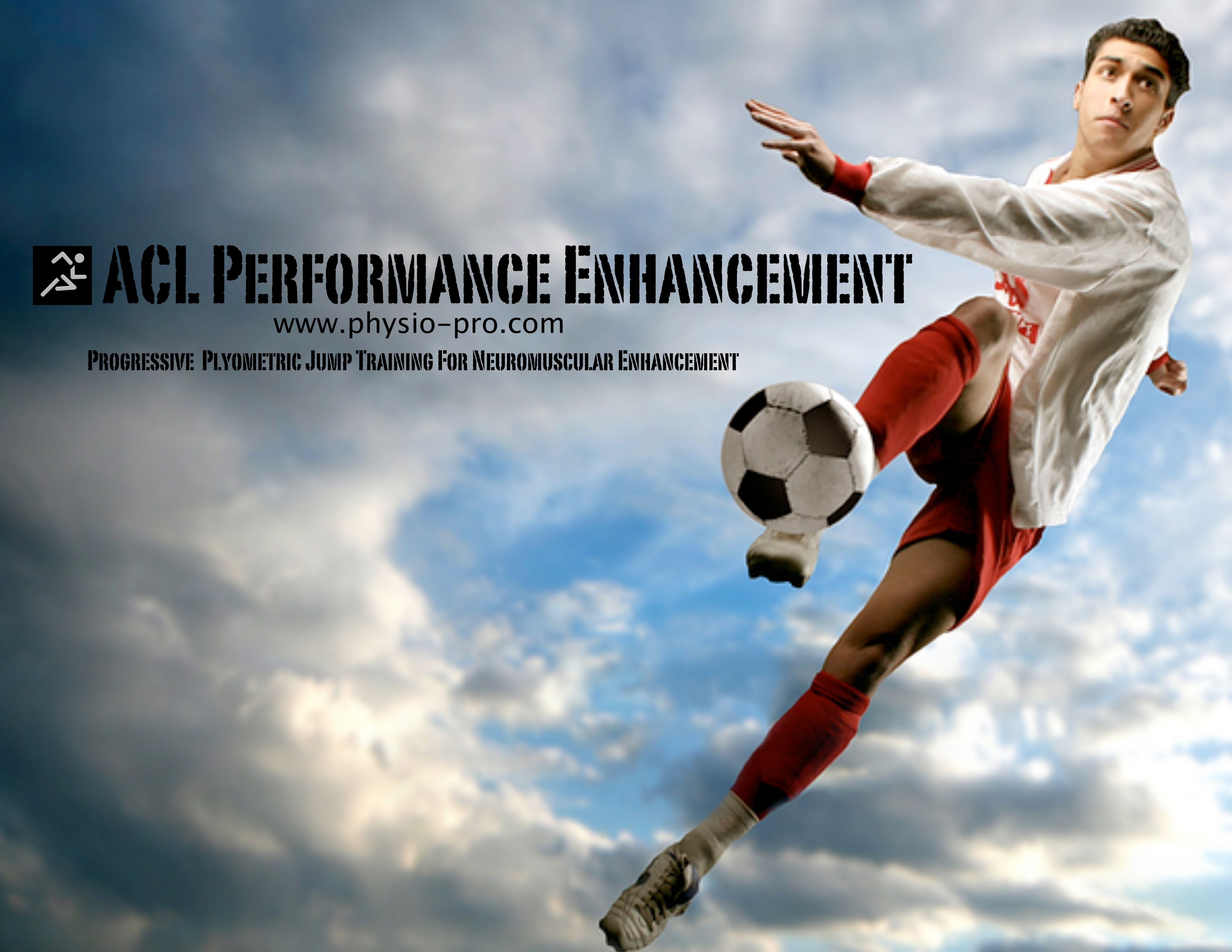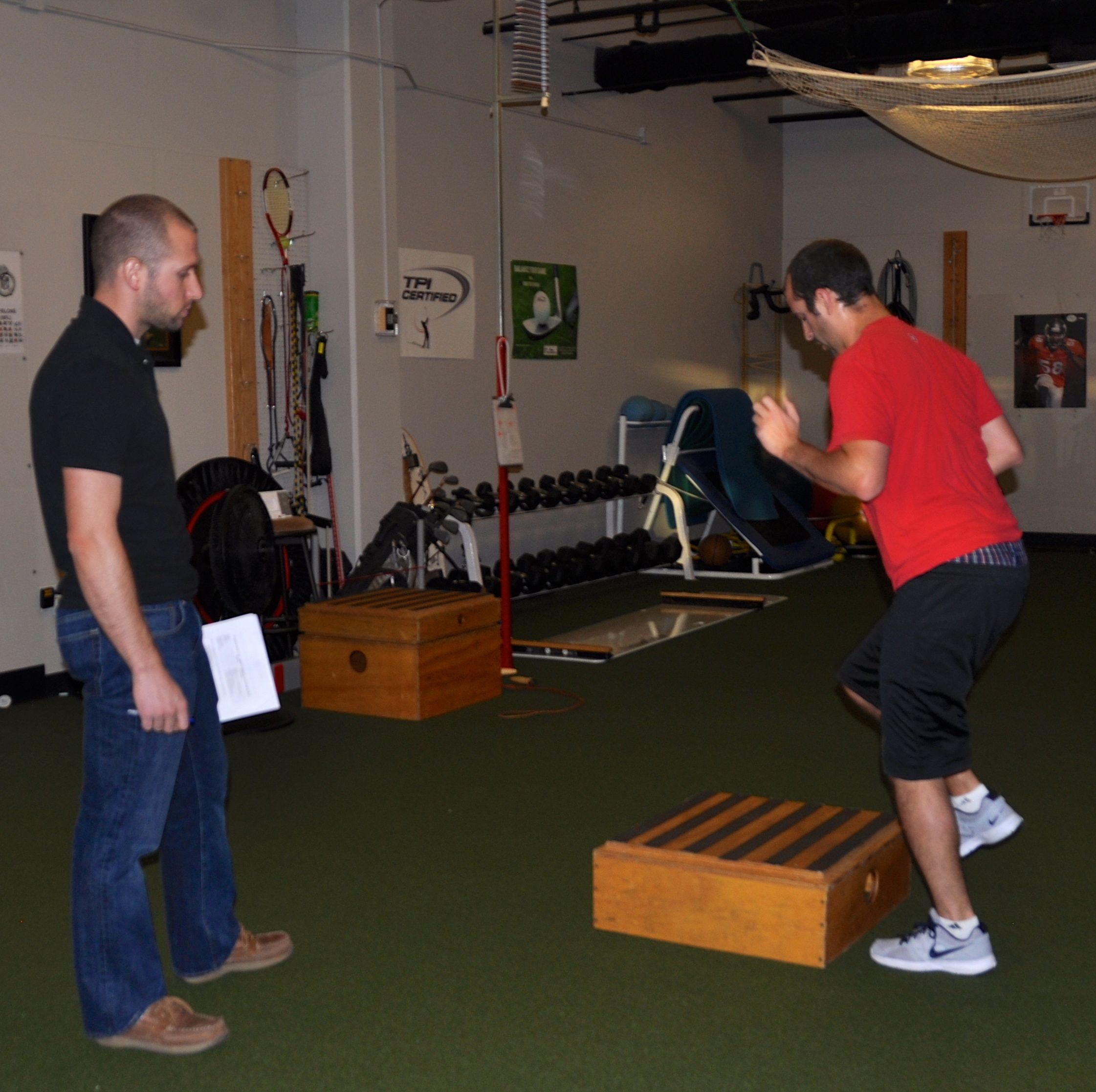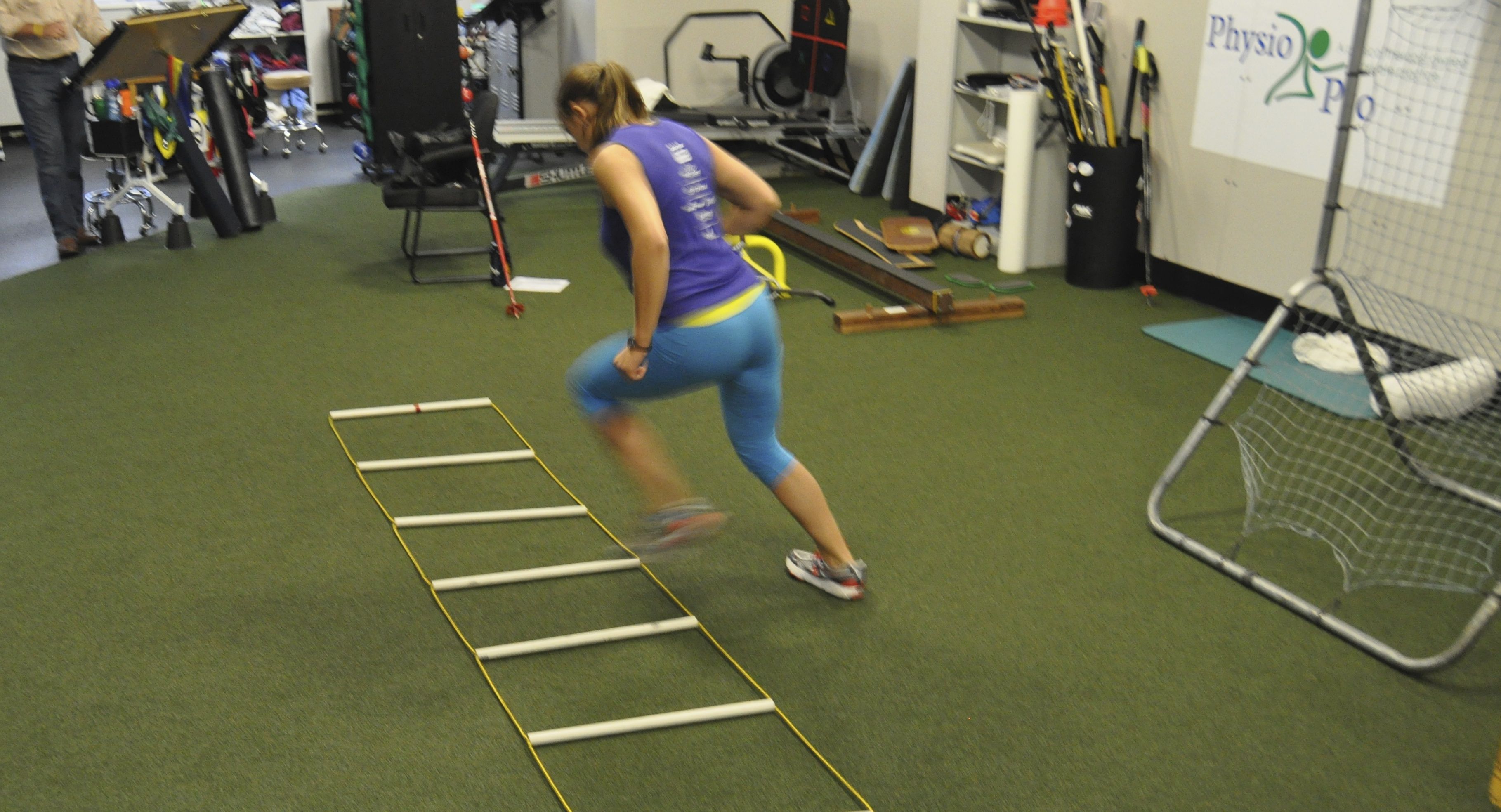The Physio Pro ACL Rehabilitation Program:
A CRITERION-BASED APPROACH IN TRANSITIONING THE POSTOPERATIVE ACL SAFELY BACK TO IMPACT ACTIVITES AND COMPETITION

Nathan Lilley MPT, OCS, CSCS
Traditional rehabilitation following ACL reconstruction has always been an ever-evolving practice. We have gone from immobilization to accelerated rehab and everywhere in between as far as our rehab progressions. Traditional rehab protocols have often utilized a time based approach to treatment progression. This “cookbook” approach has often caused clinicians to push their patients more aggressively than appropriate. Although post-operative time often has a strong influence in progression, not all patients fall within the “norms” at a given point in time. Co-morbidities, age, complications with surgery and even differences between doctors surgical techniques and philosophies all come into play with rehab progression. It is the responsibility of the clinician to constantly assess and reassess the objective status of the patient to ensure patients progress with their rehabilitation appropriately.
One of the most controversial and challenging dilemma to the clinician is knowing when to safely progress a patient from standard rehab (ROM ,PRE, Proprioception training, Etc.) into impact and more sport specific training. The purpose of the following protocol is to take a research derived criterion-based approach to progressing a patient all the way back to their given sport. Soft tissue healing, graft selection and incorporation, dynamic stability, range of motion, and patient confidence all have be taken into account. Specific clinical “mile stones” have been outlined and must be met before progressing into the next phase of training. Following such guidelines allows us to safely monitor and control the many variables that go into progressing rehab as safely and quickly as possible. The patient should be carefully monitored throughout this progression with the clinician watching for any signs of abnormal joint stress, effusion or pain.
Over the last 10 years, a wealth of research has been focused on ACL injury prevention. Prevention programs have been shown to drastically decrease the incidence of catastrophic knee injuries as well as improve athletic performance. Physio Pro has taken this information into account and incorporated an “enhancement/return to impact” program consisting of progressive plyometrics beginning at about 8 weeks post-operatively extending to the 4-6 month mark. Once an athlete has completed the protocol they are put through a comprehensive return to sport test. This too is criterion based. If the clinician, athlete and surgeon all agree that the clinical goals are met, then medical release can be considered.
The risk factors of ACL injury have been well documented over the last twenty years.
Intrinsic factors such as notch width, tibial slope, recurvatum, and hormonal influences and many other variables are thought to contribute to ACL injuries. These are variables that we cannot control as therapists. As clinicians, we turn our focus to the extrinsic variables that can be modified and adapted through training that have been shown to contribute to catastrophic knee injuries. It is the purpose of this protocol to identify and teach our patients such risk factors and how to modify activities to decrease these risks after ACL reconstruction.
It has been estimated that up to 90% of all ACL injuries occur from non-contact mechanisms. Clinical studies have indicated that such injuries usually occur during a landing from a jump or from deceleration prior to a change in direction. Usually this involves an awkward movement or a need to unexpectedly change direction directly prior to the injury. The same studies have shown there usually is an apparent valgus or dynamic valgus in the coronal plane prior to injury. This vulnerable position or “the point of no return” for ACL injury has been defined as internal femoral rotation, knee valgus, external tibial rotation, with foot pronation. Knee flexion angles of 45 degrees or less have shown an increase in anterior tibial shear as the quadriceps is contracting eccentrically to slow the landing momentum. Athletes that demonstrate these mechanics are termed ligament dominant and very susceptible to injury. During all phases of the protocol, we are constantly instructing our patients to minimize these faulty movement patterns stressing that our athletes land with strong athletic positioning utilizing the quads, hamstrings and gluteals to absorb and control the amount of shear at the knee through co-contraction. This form of training is referred to as plyometric exercise.
Plyometric exercise can be defined as an activity in which an eccentric muscle contraction (lengthening) is quickly followed by a concentric muscle contraction (shortening) and is repeated for a given duration. This process of contract-lengthen, contract-shorten is often referred to as the stretch – shortening cycle. Almost all athletic movements involve this stretch-shortening cycle. Pylometrics can be broken up into four stages. They are as follows:
- Pre-activation Phase
- Concentric Phase (Acceleration Phase)
- Eccentric Phase (Deceleration Phase)
- Amortization (Coupling Time)
Most injury rehabilitation programs fail to realize that an eccentric muscle contraction can be up to three times more forceful than a concentric muscle contraction. This is why plyometric exercises are important in the final stage of rehabilitation, to condition the muscles to handle the added strain of eccentric contractions.
The Physio Pro ACL Enhancement Program:



The first seven weeks of rehab are not outlined. At Physio Pro we use our standard ACL-R protocol for the first seven weeks until the criteria to enter the impact protocol has been met. Patients must meet the entry-level FTA criteria at a minimum of eight weeks. We will not begin the program sooner 8 weeks post-op. Progression of the program is at the discretion of the therapist/physician. Sound clinical judgment is essential for safe progression. If the criteria are not met then standard therapy will continue until objective measures are adequate.
There are a total of five phases of rehabilitation to complete before a safe return to competition can be considered. Although estimated timeframes are outlined, not all patients will progress equally as there may be complicating factors that may hinder or expedite rehabilitation. Below are the criteria for progression through the various phases of our protocol. Rehabilitation. Anticipated timelines and suggested interventions are found on the following pages.
Patients must commit themselves to a vigorous but safe 4 to 6 month rehab regime to insure safety and protection of their new ACL before returning to unrestricted activities.
Suggested Frequency of Training throughout the Impact Protocol: 3 days a week on non-consecutive days.
Exercise Dosage: Instead of sets and reps, Physio Pro uses time for almost all of our impact activities. We usually start with 30 seconds and increase the time as indicated in 10-second increments. As we begin to integrate patients back to impact activities, we need to “dose” the intensity, duration and amount of activity accordingly. In the early phases of our protocol, we encourage clinicians to have their patients warm up adequately and start their program with the given Plyometric activities. This is to prevent poor form secondary to muscular fatigue early in the protocol. At the later stages we reverse this to challenge our patients while they are fatigued insisting they maintain good form throughout the activity throughout the phases exercise duration will increase. The goal is to complete as many touches as possible using proper technique. If the athlete fatigues and loses proper technique, they should stop and rest until they can perform them properly again. At any point during the protocol if the patients loses form, or has joint pain the activity is stopped.
Resistance Training: We continue appropriate traditional progressive resistive exercise in conjunction with the impact protocol targeting muscle groups that display deficiencies. Examples of traditional strength exercises extend far beyond the scope of this document.
Important Components to the Impact Protocol
- Choose you patients appropriately. Not all patients need to reach this level of rehab. Know your patients and their ultimate goals.
- Follow functional testing criteria to assure safe participation/progression into the given phase of the program
- Know your physician. Some surgeons want to prolong soft tissue healing times. When in doubt, contact the doctor before progressing to more vigorous activity.
- Utilize Rest Breaks to restore short-burst creatine phosphate and fast glycolitic energy systems Double or triple the time/duration for the desired exercise for its subsequent rest/recovery period.
- Encourage patients to be hydrated and properly nourished prior to vigorous exercise.
- Please consider proper footwear and use a firm but forgiving surface.
- Correct posture and body alignment is the focus for all phases.
- Utilize controlled quiet landings, landing in a toe→ ball→ heel→ toe pattern for most jumps.
(Activates the hamstring/quad co-contraction and minimizes joint reaction forces) Special situations requiring different landings will be discussed later in the program. - Minimize amortization phase (landing of first jump should be the beginning of the next jump) This stresses good quick eccentric muscle control.
- Land with knees bent greater than 60 degrees of flexion. After 60 degrees of flexion, the hamstrings and quadriceps work together through co-contraction. The Quadriceps becomes an ACL agonist vs. antagonist.
- Land with strong Athletic positioning with the feet shoulder width apart, the knees comfortably flexed, shoulders back, chest over the knees, and the center of balance over the balls of the feet.
- Avoid Dynamic Valgus Moment or knock-knees positioning with landing
ESTIMATED WEEKS 8-10
IMPACT PHASE A: Entry Level Plyometrics
| ROM | 0-0-125 |
| Effusion | Minimal to none, no joint line tenderness |
| Strength | 65% quad |
| 30% HS/Quad Ratio | |
| Special Testing | Satisfactory Lachman/Drawer |
| Functional Score | >6 score on Cinti Knee Rating System |
| Functional Testing | 1 Minute Step Test > 60%, Satisfactory squat test, step-down test |
- Shuttle-bilateral (3x 20)
- Shuttle-alternating (3 x20)
- Lateral bounding in place (3x 30″)
- Slide Board (3 x 30″)
- Jog in place (second week) (3 x 30″)
- High knees in place (second week) (3x 30″)
- Gluteal kicks in place (second week) (3x 30″)
ESTIMATED WEEKS 10-12
IMPACT PHASE B: Transitional Plyometrics /Phase- Level I Agility
| ROM | 0-0-130 |
| Effusion | Minimal to none, no joint line tenderness |
| Strength | 70% quad |
| 30% HS/Quad Ratio | |
| Special Testing | Satisfactory Lachman/Drawer |
| Functional Score | >6 score on Cinti Knee Rating System |
| Functional Testing | None |
- Shuttle-bilateral grid jumps (1x 20 CW, 1x 20 CCW)
- Shuttle-alternating (2×20)
- Shuttle unilateral grid hops (1x 20 CW, 1x 20 CCW)
- Lateral bounding in place – 3 point (3×40″)
- Lateral bounding with rotation (1 x 30″ R, 1×30″ L)
- Step work: Quick feet (second week) (1 x 30″)
- Step work: Ali shuffle (second week) (1 x 30″)
- Step work: Lateral quick feet (second week) (1 x 30″)
- Step work: Lateral skaters (second week) (1 x 30″)
- Return to jogging program (treadmill) (second week)
(3W-1J-1W-3J-3W-5J- 1W progression)
ESTIMATED WEEKS 12-14
IMPACT PHASE C: Level II Agility, Sport Specific Movement
| ROM | 0-0-135 |
| Effusion | Minimal to none, no joint line tenderness |
| Strength | 75% quad |
| 60-65% HS/Quad Ratio | |
| Special Testing | Satisfactory Lachman/Drawer |
| Functional Score | >7 score on Cinti Knee Rating System |
| Functional Testing | No pain, gait deviation with 10 min TM jog |
Continue jogging program on treadmill 2-3 days a week on non-protocol days
- Jump Rope: Bilateral (1 x 1′)
- Jump Rope: Alternating ( 1′ R, 1′ L)
- Step work: Quick feet (2x 30″)
- Step work: Lateral quick feet (2 x30″)
- Step work: Ali shuffle (2×30″)
- Step work: Lateral skaters (2×30″)
- Lateral Bounding with Rotation- 3 point (2 x 30″ R, 2 x 30″L)
- Sport cord: Forward (1/2 speed) (2 x 20)
- Sport Cord: Backwards (1/2 speed) (2 x20)
- Sport Cord: 3 point Lateral Bounding (2x 30″ R, 2 x 30″L)
- Dynamic Sports routine (second week) (1x)
- Agility Ladder: “High Knees” (second week) (3x)
- Agility Ladder: Lateral “High Knees” (second week) (3x)
- Agility Ladder: Lateral Quick Feet “Ins and Outs” (front lead) (second week) (3x)
- Agility Ladder: Lateral Quick Feet “Ins and Outs “(back lead) (second week)(3x)
- Agility Ladder: “Ali Shuffle” (second week) (3x)
- Agility Ladder: “Icky Shuffle” (second week) (3x)
ESTIMATED WEEKS 14-16
IMPACT PHASE D: Level III Agility, High Level Sport Specific Movement
| ROM | Within 90% contralateral limb |
| Effusion | Minimal to none, no joint line tenderness |
| Strength | 75 to 70% quad |
| 65-70% HS/Quad Ratio | |
| Special Testing | Satisfactory Lachman/Drawer |
| Functional Score | >7 score on Cinti Knee Rating System |
| Functional Testing | SL hop 30% , Broad Jump with sound mechanics |
Continue Jogging program and transition to outdoors.
- Dynamic Sports routine (warmup)
- Sport cord: Forward (3/4 speed) (2x 20)
- Sport Cord: Backwards (3/4 speed) (2 x20)
- Sport Cord: Lateral Shuffles (1 x 20 R, 1x 20 L)
- Sport Cord: 3 Point Lateral Bounding with Rotation (2x 30″R, 2 x30″L)
- Sport Cord: 3 Point Drill Forward(second week) (20x)
- Sport Cord: 3 Point Drill Backward(second week) (20x)
- Agility Ladder: “High Knees” (4x)
- Agility Ladder: Lateral “High Knees” (4x)
- Agility Ladder: Lateral Quick Feet “Ins and Outs”(front lead) (4x)
- Agility Ladder: Lateral Quick Feet “Ins and Outs” (back lead) (4x)
- Agility Ladder: “Ali Shuffle ” (4x)
- Agility Ladder: “Icky Shuffle” (4x)
IMPACT PHASE E: Physio Pro Jump Program
ESTIMATED WEEKS 16-22 (Minimum Criteria to Enter Full Plyometric Program)
6 days a week X 6 weeks
( 3 Days Plyometrics / 3 Days Functional Strengthening)
| ROM | Within 90% contralateral limb |
| Effusion | Minimal to none, no joint line tenderness |
| Strength | 75 to 70% quad |
| 65-70% HS/Quad Ratio | |
| Special Testing | Satisfactory Lachman/Drawer |
| Functional Score | >7 score on Cinti Knee Rating System |
| Functional Testing | SL hop 60% , Broad Jump with sound mechanics Good form with eccentric step-down test |
Dynamic Sports Routine Warm Up (All 6 Weeks)
Functional Strengthening (All 6 Weeks, Every Other Day, Non-Jump Days)
- Hip Hinges: Sustained Isometric Squat
- Cook Hip Lift
- Fire Hydrants
- Split Leg Squat/Chair Dip
- Plank x 4
- Multidirectional Lunge
- Unilateral Straight Leg Dead Lift
- Straight Leg Abduction with External Rotation
- Lunge Walk
Plyometrics Phase I: 2 Weeks, 3x a week
- Wall/Block Jump
- Broad Jump
- Squat/Vertical Jump
- 180/Half Spin Jump
- Lateral Bounding In Place
- Scissors/Rudder Jump
- Richochets- Bilateral- Side to Side
- Richochets- Bilateral- Back to Front
Plyometrics Phase II: 2 Weeks, 3x a week
(continue dynamic warm-up and functional strengthening)
- Wall/Block Jump
- Tuck Jump
- Jump, Jump, Jump, Vertical Jump
- Squat/Vertical Jump
- Lateral Bounding for Distance
- Scissors/Rudder Jump
- Richochets- Bilateral- Side to Side
- Richochets- Bilateral- Back to Front
- Richochets- Unilateral- Side to Side
- Richochets- Unilateral- Back to Front
- Hop, Hop, Hop Stick
Plyometrics Phase III: 2 Weeks, 3x a week
(continue dynamic warm-up and functional strengthening)
- Squat/Vertical Jump
- Jump Up, Jump Down, Vertical Jump
- Tuck Jump
- Scissors/Rudder Jump
- Jump Into Bounding for Distance
- Richochets- Bilateral- Side to Side
- Richochets- Bilateral- Back to Front
- Richochets- Unilateral- Side to Side
- Richochets- Unilateral- Back to Front
- Single Leg hop and Stick
4-6 Months Post-Op (Return to Competition Criteria)
| ROM | Within 90% contralateral limb |
| Effusion | Trace to none, no JLT |
| Strength | 80 to 85% quad or greater |
| 70-75% HS/Quad Ratio | |
| Special Testing | Satisfactory Lachman/Drawer |
| Functional Score | >8 score on Cinti Knee Rating System |
| Functional Testing | SL hop >85%, Pass RTC criteria Physician Clearance Must have prior to release |
